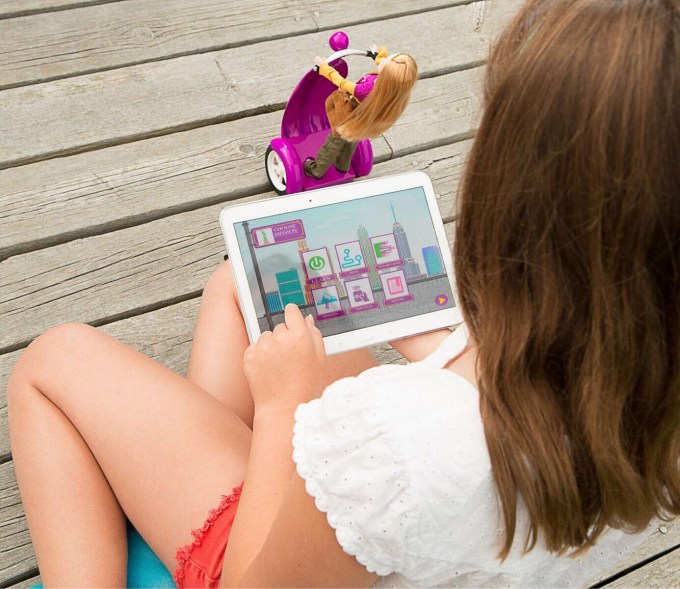[ad_1]

In the race to greater consumer adoption, augmented reality is emerging as the early leader, thanks to its adoption by a key consumer market.
The technology has always been a wonder, drawing its strength from its capacity to make just about any subject come to life, popping out of the real ground beneath our feet and conjuring up digital apparitions that serve as extensions of our own imagination onto the physical world around us.
That ability to create wonder in the everyday, without total immersion, also provides a clue for why AR adoption has been faster (aside from technical limitations that still bedevil VR). One indicator of how the market is apparently more comfortable with AR than it is with its immersive sibling, VR, is that one of its earliest adopters are toymakers. In fact, the Toy Industry Association named augmented reality and related technologies the top toy trend for 2016.
“Think of the drama, dance, fine art and sculpture opportunities that AR brings. Kids could watch famous actors perform Shakespeare monologues in their living room.” Catherine Allen, AR/VR specialist & kids app producer, who has worked on products like Barefoot World Atlas and Elmer’s Photo Patchwork, told me. “They could see what a famous Henry Moore sculpture looks like, in their garden!”
Earlier this month the AR startup Osmo, which creates board games, puzzle pieces and blocks that interact with mobile games and iPads, raised $24 million. Over 22,000 schools have adopted its products, a 5-fold increase from a year ago, according to the company.
Most parents may be reluctant to expose their kids to VR experiences because of the lack of safety research. AR, on the other hand, isn’t immersive, and plays out as a digital layer that enhances, or enables further, what is possible to do in real life.
“One of the sweet spots for AR on phones and tablets is at the intersection of toys and games. I would generally call them kids products.” Jay Wright, President and General Manager of Vuforia at PTC, the company behind the platforms that power many of the toys and games that run on AR, says. “Some are strictly for entertainment use, but many of them are designed to be educational. More and more of them are beginning to support STEM education.”
One example of this new push toward STEM-focused, educational gaming is SmartGurlz, an AR startup launched by an American expat living in Denmark.
It all began with the simple wish of its founder to help her teenage daughter with math and evolved into an experience tailored to girls with the aim of instilling an interest in science and technology. The video-equipped ‘Siggy Robots’ carry out missions and adventures that require its audience of young female players to learn to code along the way in order to complete each of the story-based challenges.
“This is really an exciting time where AR is used to reinspire learning again. Kids are now exposed to so much great technology in their leisure time and yet so little innovation goes into teaching.” Sharmi Albrechtsen, founder and CEO at SmartGurlz, says. “It’s really a pity – since it is a huge potential from a market perspective but also societal. Many kids lose interest in STEM because we have not been able to excite them!”

SmartGurlz launched last month and sold out on Amazon.
“I strongly believe that when it comes to STEM or teaching, the most important thing is to first capture the imagination of the students and then their curiosity” Silas Adekunle, Cofounder and CEO of Reach Robotics, a UK-based startup that combines robotics with AR in the gaming space, told me. “AR has so much potential to make classrooms more interactive and engaging, with new ways to visualize complex information.”
Other examples of AR-powered toys and games, many of them STEM-focused, that have hit the shelves this holiday season include: Hologrid: Monster Battle; Neobear Magnifier NEO; Virtual Explorer Antopia Adventure; AirHogs Connect Mission Drone; and Skylanders. And it hasn’t come with the kind of collateral damage or disruptive cost to traditional toymakers as we might have expected.
“The interesting part is that the products and manufacturers that succeed use technology to enhance the play value of the products they bring to market,” Reyne Rice, chief executive of ToyTrends told the BBC in September.
This new breed of digitized toys and games introduces a digital layer that creates additional value to the underlying business proposition for toymakers.
An example is Danish toymaker Lego’s Nexo Knights, named ‘Toy of the Show’ at the London Toy Fair 2016 and also powered by Vuforia. The AR component of its multiplatform gaming ecosystem depends, in part, on the expanded product line. For example, players can unlock new features, powers, and game levels, by purchasing new toy sets.
“If it can drive additional purchases of physical toys, that’s a really good model. It’s like the razor and razor blade dynamic. The digital game is the razor and the physical toys are the razor blades.” Wright says.
The digital soul that has been instilled in the physical toy allows for the industry to establish a stronger narrative with the kids who play its games and in turn only strengthens the way toymakers can market, engage, and sell their products. Instead of threatening to cannibalize their current offering, AR actually serves to enhance and expand it.
Source link
 Tech News code
Tech News code


